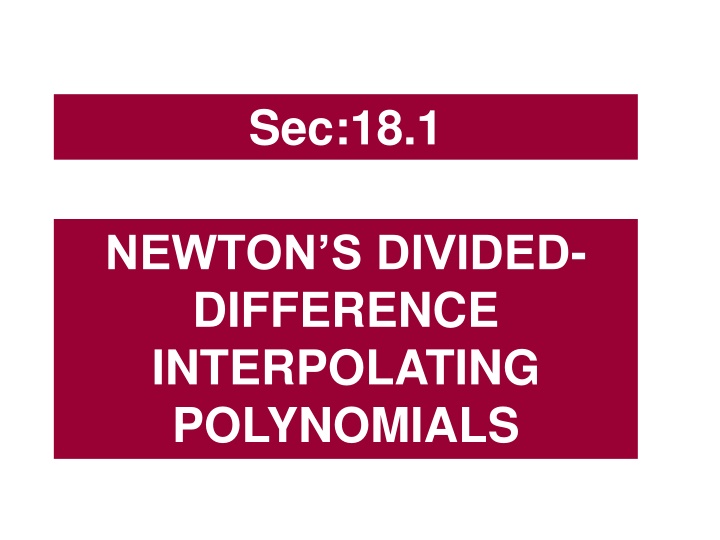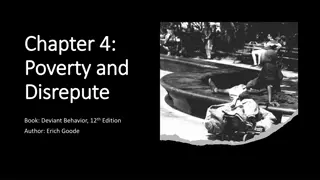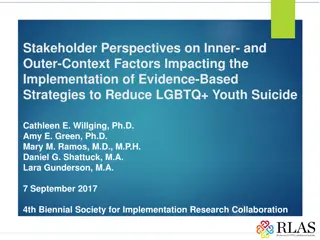Factors and Evidence on Deviance in Youth Studies
Indicative factors and evidence candidates may refer to in studying youth deviance, including concepts, theories, and studies by various researchers. Analysis and evaluation of factors in youth deviance exploration.
Download Presentation

Please find below an Image/Link to download the presentation.
The content on the website is provided AS IS for your information and personal use only. It may not be sold, licensed, or shared on other websites without obtaining consent from the author.If you encounter any issues during the download, it is possible that the publisher has removed the file from their server.
You are allowed to download the files provided on this website for personal or commercial use, subject to the condition that they are used lawfully. All files are the property of their respective owners.
The content on the website is provided AS IS for your information and personal use only. It may not be sold, licensed, or shared on other websites without obtaining consent from the author.
E N D
Presentation Transcript
Sec:18.1 NEWTON S DIVIDED- DIFFERENCE INTERPOLATING POLYNOMIALS
Sec:18.1 NEWTONS DIVIDED-DIFFERENCE INTERPOLATING POLYNOMIALS How many lines passes through these two points ? How many parabola passes through these three points ? How many polynomial of degree one passes through these two points ? How many polynomial of degree two passes through these three points ? there is one and only one polynomial of order n that passes through all the points. Polynomial interpolation consists of determining the unique nth-order polynomial that fits n + 1 data points. How many polynomial of degree n passes through these (n+1) points ?
Sec:18.1 NEWTONS DIVIDED-DIFFERENCE INTERPOLATING POLYNOMIALS Polynomial interpolation consists of determining the unique nth-order polynomial that fits n + 1 data points. How many polynomial of degree n passes through these (n+1) points ? Applications X Y X x1 x2 xn f(x) f(x1) f(x2) f(xn) Sometimes we need to estimate intermediate values between precise data points. 2.1 3.7 35.6 99.0 23.56 22.12 Sometimes we need to a function by nth-order polynomial
Sec:18.1 NEWTONS DIVIDED-DIFFERENCE INTERPOLATING POLYNOMIALS Linear Interpolation Example Estimate the natural logarithm of 2 using linear interpolation. First, perform the computation by interpolating between ln 1 = 0 and ln 6 = 1.791759. (?0,? ?0) ? ? (?1,? ?1) ?12 ?? 1 2 1 =?? 6 ?? 1 6 1 ?1? =? ?1 ? ?0 ? ?0 + ?(?0) ?1 ?0 ?1? ? ?0 ? ?0 =? ?1 ? ?0 ?1 ?0 ?12 1 =1.791759 5 = 0.3583519 The notation ?1designates that this is a first order interpolating polynomial.
Sec:18.1 NEWTONS DIVIDED-DIFFERENCE INTERPOLATING POLYNOMIALS Quadratic Interpolation ? ? (?0,? ?0) ?0 ?0 ?1 ?2 ? ? ? ?0 ? ?1 ? ?2 (?2,? ?2) (?1,? ?1) A particularly convenient form ?2? = ??+ ??? ?0 + ??? ?0 ? ?1 ??= ? ?0 ?2?0 = ? ?0 ??=? ?1 ? ?0 ?1 ?0 ?2?1 = ? ?1 ?2?2 = ? ?2 ? ?2 ? ?2 ?2 ?1 ? ?1 ? ?0 ?1 ?0 ?2 ?0 ??=
Sec:18.1 NEWTONS DIVIDED-DIFFERENCE INTERPOLATING POLYNOMIALS A particularly convenient form ?2? = ??+ ??? ?0 + ??? ?0 ? ?1 finite divided differences ??= ? ?0 ??=? ?1 ? ?0 ?1 ?0 ? ?2 ? ?1 ?2 ?1 ??= ?[?0] ??= ?[?1,?0] ? ?1 ? ?0 ?1 ?0 ?2 ?0 ??= ?[?2,?1,?0] ??= Definition: ? ?? ? ?? ?? ?? ?[??,??]= ? ??,?? 1, ,?1,?0 =? ??,?? 1, ,?1 ? ?? 1, ,?1,?0 ?? ?0
Sec:18.1 NEWTONS DIVIDED-DIFFERENCE INTERPOLATING POLYNOMIALS Definition: ? ?? ? ?? ?? ?? ?[??,??]= second finite divided difference ? ??,?? 1, ,?1,?0 =? ??,?? 1, ,?1 ? ?? 1, ,?1,?0 ?? ?0 nth finite divided difference A polynomial of order 2 that passes through the three points (?0,?(?0)), (?1,?(?1)), (?2,?(?2)). ?2? = ??+ ??? ?0 + ??? ?0 ? ?1 ?2? = ?[??] + ?[??,??] ? ?0 + ?[??,??,??] ? ?0 ? ?1
Sec:18.1 NEWTONS DIVIDED-DIFFERENCE INTERPOLATING POLYNOMIALS Example Fit a second-order polynomial to the three points ? ? ? ?0=1 ?1=2 ?2=4 ? ?0=1 ? ?1=8 ? ?2=14 ? ??,?? =? ?? ? ?? =? ? ? ?= ? ?? ?? ? ??,??,?? =? ??,?? ? ??,?? =? ? ? ?= ? ?? ?? ? ? ??,?? =? ?? ? ?? =?? ? ? ?= ? ?? ?? ?2? = ?[??] + ?[??,??] ? ?0 + ?[??,??,??] ? ?0 ? ?1 ?2? = ? + ? ? 1 ? ?? 1 ? 2
Sec:18.1 NEWTONS DIVIDED-DIFFERENCE INTERPOLATING POLYNOMIALS Definition: ? ?? ? ?? ?? ?? ?[??,??]= second finite divided difference ? ??,?? 1, ,?1,?0 =? ??,?? 1, ,?1 ? ?? 1, ,?1,?0 ?? ?0 nth finite divided difference General Form of Newton s Interpolating Polynomials A polynomial of order n that passes through the (n+1) points (?0,?(?0)), (?1,?(?1)), ,(??,?(??)). ??? = ??+ ??? ?0 + ??? ?0 ? ?1 + + ??? ?0 ? ?1 ? ?? 1 ??? = ?[??] + ?[??,??] ? ?0 + ?[??,??,??] ? ?0 ? ?1 + + ?[??,?? ?, ,??] ? ?0 ? ?1 ? ?? 1
Sec:18.1 NEWTONS DIVIDED-DIFFERENCE INTERPOLATING POLYNOMIALS notice how divided differences are recursive that is, higher-order differences are computed by taking differences of lower-order differences.
Sec:18.1 NEWTONS DIVIDED-DIFFERENCE INTERPOLATING POLYNOMIALS Example ?? ?(??) 1 3 2 6 3 19 5 99 Calculate f (4) using Newton s interpolating polynomials of order 1 through 3. Given the data First Second Third ?? 1 2 3 5 ?[??] 3 6 19 99
Sec:18.1 NEWTONS DIVIDED-DIFFERENCE INTERPOLATING POLYNOMIALS Example ?? ?(??) 1 3 2 6 3 19 5 99 Calculate f (4) using Newton s interpolating polynomials of order 1 through 3. Given the data First Second Third ?? ?[??] 1 3 3 5 1 2 6 13 9 3 19 40 5 99 ??? = ? + ?(? ?) ??? = ?? ??? = ? + ? ? ? + ?(? ?)(? ?) ??? = ?? ??? = ? + ? ? ? + ? ? ? ? ? + (? ?)(? ?)(? ?) ??? = ??
Sec:18.1 NEWTONS DIVIDED-DIFFERENCE INTERPOLATING POLYNOMIALS Example x 1.0 0.7651977 1.3 0.6200860 1.6 0.4554022 1.9 0.2818186 2.2 0.1103623 f (x) Complete the divided difference table for the data given in the adjacent Table and construct the interpolating polynomial that uses all this data. First Second Third Fourth ?? ? ?? ? 0 1.0 0.4837057 0.1087339 0.0658784 0.0018251 0.7651977 1 1.3 0.5489460 0.0494433 0.0680685 0.6200860 2 1.6 0.5786120 0.0118183 0.4554022 3 1.9 0.5715210 0.2818186 4 2.2 0.1103623 ??(?) = ?.??????? ?.??????? ? ?.? ?.??????? ? ?.? ? ?.? + ?.??????? ? ?.? ? ?.? ? ?.? + ?.???????(? ?.?)(? ?.?)(? ?.?)(? ?.?) The coefficients of the Newton forward divided-difference form of the interpolating polynomial are along the first row in the table.
Sec:18.1 NEWTONS DIVIDED-DIFFERENCE INTERPOLATING POLYNOMIALS First Second Third Fourth ?? ? ?? ? 0 1.0 0.4837057 0.1087339 0.0658784 0.0018251 0.7651977 1 1.3 0.5489460 0.0494433 0.0680685 0.6200860 2 1.6 0.5786120 0.0118183 0.4554022 3 1.9 0.5715210 0.2818186 4 2.2 0.1103623 ??(?) = ?.??????? ?.??????? ? ?.? ?.??????? ? ?.? ? ?.? + ?.??????? ? ?.? ? ?.? ? ?.? + ?.???????(? ?.?)(? ?.?)(? ?.?)(? ?.?) Remark Remark Remark The coefficients of the Newton forward divided-difference form of the interpolating polynomial are along the first row in the table. The poly of degree 1 for (1.0.7651977) and (1.3,0.6200860) If poly of degree 5 is needed, then just complete the diagonal . ??(?) = ?.??????? ?.??????? ? ?.?
Sec:18.1 NEWTONS DIVIDED-DIFFERENCE INTERPOLATING POLYNOMIALS data=[1.0 0.7651977; 1.3 0.6200860; 1.6 0.4554022; 1.9 0.2818186; 2.2 0.1103623]; function [d]=Divided_diff(x,y) d=y; n=length(x); for j=2:n for k=n:-1:j d(k)=(d(k)-d(k-1))/(x(k)-x(k-j+1)); end end x =data(:,1); y=data(:,2); [d]=Divided_diff(x,y); d First Second Third Fourth ?? ? ?? ? 0 1.0 0.4837057 0.1087339 0.0658784 0.0018251 0.7651977 1 1.3 0.5489460 0.0494433 0.0680685 0.6200860 2 1.6 0.5786120 0.0118183 0.4554022 3 1.9 0.5715210 0.2818186 4 2.2 0.1103623
Sec:18.1 NEWTONS DIVIDED-DIFFERENCE INTERPOLATING POLYNOMIALS Example ?? ?(??) 1 3 2 6 3 19 5 99 7 291 Write the Newton s interpolating polynomials of order 4. Given the data First Second Third Fourth ?? 1 2 3 5 7 ?[??] 3 6 19 99 291
Sec:18.1 NEWTONS DIVIDED-DIFFERENCE INTERPOLATING POLYNOMIALS Example ?? ?(??) 1 3 2 6 3 19 5 99 7 291 Write the Newton s interpolating polynomials of order 4. Given the data First 3 13 40 96 Second 5 9 14 Third 1 1 Fourth 0 ?? 1 2 3 5 7 ?[??] 3 6 19 99 291
Sec:18.1 NEWTONS DIVIDED-DIFFERENCE INTERPOLATING POLYNOMIALS Example Problem 18.2 pp522 x=[8 9 11 12]; y=log10(x); 0.9031 0.0512 -0.0025 0.0001 Fit a third-order Newton s interpolating polynomial to estimate log(10) using the data at x = 8, 9, 11 and 12. Compute the true percent relative error. [d]=Divided_diff(x,y); d [yi] = eval_poly(x,d,10) Rel_err = (yi-1)/1*100 function [yi] = eval_poly(x,d,xi) yi = d(1); prod = 1; n = length(d); for k=1:n-1 prod=prod*(xi-x(k)) yi=yi+d(k+1)*prod; end ?? ?(??) 8 9 11 12 0.9031 0.9542 1.0414 1.0792 ??(?) = 0.9031+0.0512 ? ? 0.0025 ? ? ? ? + 0.0001 ? ? ? ? (? ??) ??(??) = 1.000044924225105 True percent relative error = 0.0045%
Sec:18.1 NEWTONS DIVIDED-DIFFERENCE INTERPOLATING POLYNOMIALS Example Problem 18.2 pp522 x=[0 pi/2 pi 3*pi/2 2*pi]; y=sin(x); [d]=Divided_diff(x,y); xx=[0:0.1:2*pi]; [yy] = eval_poly(x,d,xx); ezplot('sin(x)',[0,2*pi]); grid on; hold on plot(xx,yy); plot(x,y,'k*'); hold off Fit a 4th-order Newton s interpolating polynomial to approximate sin(x) using the data at x = 0, pi/2, pi, 3*pi/2 and 2*pi. Plot sin(x) and ?4(?). ? = ???(?) ??(?)
Sec:18.1 NEWTONS DIVIDED-DIFFERENCE INTERPOLATING POLYNOMIALS Errors of Newton s Interpolating Polynomials ??? = ? ??+ ? ??,?? ? ?0 + + ?[??, ,??] ? ?0 ? ?? 1 ? ? ??? = ??(?) ??(?) =??+1? ? ?0 ? ?? (? + 1)! The structure is similar to the Taylor series expansion in the sense that terms are added sequentially to capture the higher-order behavior. ??,??????=??+?? Taylor series ?+? ? ?? (? + ?)! ? ? = ? ?? +? ?? ? ?? + +???? ?+ ??,?????? ? ?? ?! ?!
Sec:18.1 NEWTONS DIVIDED-DIFFERENCE INTERPOLATING POLYNOMIALS Errors of Newton s Interpolating Polynomials ??? = ? ??+ ? ??,?? ? ?0 + + ?[??, ,??] ? ?0 ? ?? 1 ? ? = ??? + ??(?) ??(?) =??+1? ? ?0 ? ?? (? + 1)! For an nth-order interpolating polynomial, an alternative relationship for the error is ??(?) = ?[?,??, ,??] ? ?0 ? ??
Sec:18.1 NEWTONS DIVIDED-DIFFERENCE INTERPOLATING POLYNOMIALS ??(?) = ?[?,??, ,??] ? ?0 ? ?? nth-order error is Example Problem 18.2 pp522 ??(?) = 0.9031+0.0512 ? ? 0.0025 ? ? ( ) ???(??) = 1.000343408828085 True error = - 3.434e-04 ? Fit a second-order Newton s interpolating polynomial to estimate log(10) using the data at x = 8, 9, and 11. Compute the true error. ?? ??(?) = ?[?,??,??,??] ? ??(? ??) ? ?? ??(??) = ?[??,??,?,?] ?? ? (?? ?) ?? ?? ?(??) (*) 8 9 11 12 0.9031 0.9542 1.0414 1.0792 ???? = ?.??????? ?? ? (?? ?) ?? ?? ??(10) = -3.434e-04 Because (*) contains the unknown f (10), it cannot be solved for the error. However, if an additional data point f (?3) is available, (*) can be used to estimate the error, as in x=[8 9 11]; y=log10(x); [d]=Divided_diff(x,y); [yi] = eval_poly(x,d,10) err = yi-1 0.9031 0.0512 -0.0025 ??(??) ?[??,??,?,?] ?? ? (?? ?) ?? ?? ???? ?.??? ? ?? ? (?? ?) ?? ?? ???? -2.985e-04
Sec:18.1 NEWTONS DIVIDED-DIFFERENCE INTERPOLATING POLYNOMIALS Notation ??(?) = ?[?,??, ,??] ? ?0(? ?1) (? ?? 1) ? ?? ? ??(?) = ?[?,??, ,??] ? ?? ?=?























